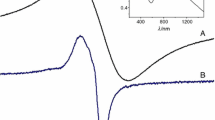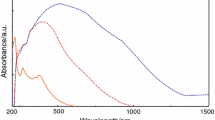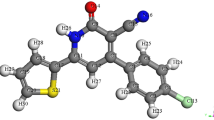Abstract
New species of type [MLCl2]·nH2O (M:Ni, n = 0; M:Cu, n = 1 and M:Zn, n = 0; L: 1,3,5,8,11-pentaazacyclotridecane-3-yl-(pyrid-3-yl)-methanone resulted by N,N’-bis(2-aminoethyl)ethane-1,2-diamine, nicotinamide and formaldehyde) were synthesised by one-pot condensation. Chemical analysis, ESI–MS, IR, 1H NMR, 13C NMR, UV–Vis–NIR, EPR spectroscopy as well as magnetic data at room temperature were used in order to characterise the compounds. The data provided by IR, ESI–MS and NMR spectra are consistent with the macrocycle formation. Electronic spectra indicate that both Ni(II) and Cu(II) adopt an octahedral stereochemistry data furthermore confirmed by magnetic moments and EPR spectrum at room temperature. The electrochemical behaviour of the compounds was investigated by cyclic voltammetry. Processes as water and chloride elimination as well as oxidative degradation of the macrocyclic ligand were observed by simultaneously TG–DTA measurements. The final residue as the most stable metallic oxide was identified by X-ray powder diffraction. The compound [CuLCl2]·H2O (2) exhibits fungicidal and anti-biofilm activity on Candida albicans strains. The complexes exhibit a low cytotoxicity on HEp 2 cells, except for Cu(II) species that induce the cellular cycle arrest in the G2/M phase.





Similar content being viewed by others
References
Lawrance GA, Maeder M, Wilkes EN. Metal-directed macrocyclization reactions involving formaldehyde, amines and mono- or bi-functional methylene compounds. Rev Inorg Chem. 1993;13:199–232.
Wainwright KP. Synthetic and structural aspects of the chemistry of saturated polyaza macrocyclic ligands bearing pendant coordinating groups attached to nitrogen. Coord Chem Rev. 1997;166:35–90.
Chandra S, Ruchia, Qanungo K, Sharma SK. New hexadentate macrocyclic ligand and their copper(II) and nickel(II) complexes: spectral, magnetic, electrochemical, thermal, molecular modeling and antimicrobial studies. Spectrochim Acta Part A Mol Biomol Spectrosc. 2012;94:312–7.
Nishata N, Manishaa R, Dhyania S. Synthesis, thermal behavior, and antimicrobial activity of a novel macrocycle and its transition metal complexes derived from thiosemicarbazide. Spectrosc Lett. 2010;43:465–73.
Chandra S, Gupta LK, Agrawal S. Synthesis spectroscopic and biological approach in the characterization of novel [N4] macrocyclic ligand and its transition metal complexes. Trans Met Chem. 2007;32:558–63.
Bernhardt PV, Kim JY, Kim Y, Lee YH, Chow S. Macrocycles and medicine: facile synthesis of a bis(macrocycle) with pendent functionality. C R Chim. 2005;8:211–4.
El-Boraey HA, Emam SM, Tolan DA, El-Nahas AM. Structural studies and anticancer activity of a novel (N6O4) macrocyclic ligand and its Cu(II) complexes. Spectrochim Acta Part A Mol Biomol Spectrosc. 2011;78:360–70.
Timmons JC, Hubin TJ. Preparations and applications of synthetic linked azamacrocycle ligands and complexes. Coord Chem Rev. 2010;254:1661–85.
Mewis RE, Archibald SJ. Biomedical applications of macrocyclic ligand complexes. Coord Chem Rev. 2010;254:1686–712.
Nirmala CG, Rahiman AK, Sreedaran S, Jegadeesh R, Raaman N, Narayanan V. Synthesis, characterization, crystal structure and antimicrobial activities of new trans N,N-substituted macrocyclic dioxocyclam and their copper(II) and nickel(II) complexes. Polyhedron. 2011;30:106–13.
Pătraşcu F, Badea M, Grecu MN, Stanică N, Măruţescu L, Marinescu D, Spînu C, Tigae C, Olar R. Thermal, spectral, magnetic and antimicrobial behaviour of new Ni(II), Cu(II) and Zn(II) complexes with a hexaazamacrocyclic ligand. J Therm Anal Calorim. 2013;113:1421–9.
Min KS, Suh MP. Construction of various supramolecules by π–π interactions: self-assembly of Nickel(II) macrocyclic complexes containing pyridine pendant arms with bidentate ligands. Eur J: Inorg Chem; 2001. p. 449–55.
Abbà F, De Santis G, Fabbrizzi L, Licchelli M, Manotti Lanfredi AM, Pallavicini P, Poggi A, Ugozzoli F. Nickel(II) complex of azacyclams: oxidation and reduction behavior and catalytic effects in the electroreduction of carbon dioxide. Inorg Chem. 1994;33:1366–75.
Bernhardt PV, Hayes EJ. Aminotriazines as locking fragments in macrocyclic synthesis. Inorg Chem. 1998;37:4214–9.
Comba P, Lampeka YD, Nazarenko AY, Prikhod`ko AI, Pritzkow H. Interaction between copper(II) complex of mono-, bis- and tris(macrociclic) ligands and inorganic or organic guests. Eur J Inorg Chem. 2002;1464–74.
Lampeka YD, Prikhod`ko AI, Nazarenko AY, Rusanov EB. Barbituric acid as a new locking fragment in macrocyclization: synthesis and structural characterisation of [aqua(perchlorate)(2`,4`,6`-trioxohexahidroxipyrimidine-5`-spiro-6-1,4,8,11-tetraazacyclotetradecane)copper(II)] perchlorate hydrate. J Chem Soc Dalton Trans. 1996;2017–8.
De Santis G, Fabbrizzi L, Licchelli M, Mangano C, Pallavicini P. The copper(II) complex of a metallocyclam-functionalized phenanthroline: a poorly stable species that is very resistent to oxidation. Inorg Chem. 1993;32:3385–7.
Fabbrizzi L, Licchelli M, Mosca L, Poggi A. Template synthesis of azacyclam metal complexes using primary amides as locking fragments. Coord Chem Rev. 2010;254:1628–36.
Bertini I, Gray HB, Stiefel EI, Valentine JS. Biological inorganic chemistry: structure and reactivity. Sausalito: University Science Books; 2007.
Kolodziejczyk AM, Brzezinka GD, Khurana K, Targosz-Korecka M, Szymonski M. Nanomechanical sensing of the endothelial cell response to anti-inflammatory action of 1-methylnicotinamide chloride. Int J Nanomed. 2013;8:2757–67.
Shrivastav A, Singh NK, Singh SM. Synthesis, characterization and antitumor studies of Mn(II), Ni(II), Cu(II) and Zn(II) complexes of N-nicotinoyl-N0-o-hydroxythiobenzhydrazide. Biometals. 2003;16:311–20.
Demir S, Yilmaz VT, Sariboga B, Buyukgungor O, Mrozinski J. Metal(II) nicotinamide complexes containing succinato, succinate and succinic acid: synthesis, crystal structures, magnetic, thermal, antimicrobial and fluorescent properties. J Inorg Organomet Polym. 2010;20:220–8.
Patel NB, Shaikh FM. New 4-thiazolidinones of nicotinic acid with 2-amino-6-methylbenzothiazole and their biological activity. Sci Pharm. 2010;78:753–65.
Dilip CS, Kumar VS, Venison SJ, Vetha potheher I, Subahashini DR. Synthesis, structural characterisation, bio-potential efficiency and DNA cleavage applications of nicotinamide metal complexes. J Mol Struct. 2013;1040:192–205.
Saviuc C, Grumezescu AM, Holban A, Bleotu C, Chifiriuc C, Balaure P, Lazar V. Phenotypical studies of raw and nanosystem embedded Eugenia carryophyllata buds essential oil antibacterial activity on Pseudomonas aeruginosa and Staphylococcus aureus strains. Biointerface Res Appl Chem. 2011;1:111–8.
Olar R, Badea M, Marinescu D, Chifiriuc C, Bleotu C, Grecu N, Iorgulescu EE, Bucur M, Lazar V, Finaru A. Prospects for new antimicrobials based on N,N-dimethylbiguanide complexes as effective agents on both planktonic and adherent microbial strains. Eur J Med Chem. 2010;45:2868–75.
Cory AH, Owen TC, Barltrop JA, Cory JG. Use of an aqueous soluble tetrazolium/formazan assay for cell growth assays in culture. Cancer Commun. 1991;3:207–12.
Darzynkiewicz Z. Nucleic acid analysis, Chap. 7. In: Robinson JP, editor. Current protocols in cytometry. New York: Wiley; 1997.
Geary WJ. The use of conductivity measurements in organic solvents for the characterisation of coordination compounds. Coord Chem Rev. 1971;7:81–122.
Köse DA, Necefoğlu H. Synthesis and characterization of bis (nicotinamide) m-hydroxybenzoate complexes of Co(II), Ni(II), Cu(II) and Zn(II). J Therm Anal Calorim. 2008;93:509–14.
Nakamoto K. Infrared and Raman spectra of inorganic and coordination compounds. New York: Wiley; 1986.
Lever ABP. Inorganic electronic spectroscopy. Amsterdam: Elsevier; 1986.
König E. The nephelauxetic effect. Calculation and accuracy of the interelectronic repulsion parameters I. Cubic high-spin d 2, d 3, d 7 and d 8 systems. Struct Bond. 1972;9:175–372.
Gispert JB. Coordination chemistry. Weinheim: Wiley; 2008.
Hathaway BJ. A new look at the stereochemistry and electronic properties of complexes of the copper(II) ion. Struct Bond. 1984;57:55–118.
Tatucu M, Rotaru P, Rau I, Spinu C, Kriza A. Thermal behaviour and spectroscopic investigation of some methyl 2-pyridyl ketone complexes. J Therm Anal Calorim. 2010;100:1107–14.
Zianna A, Vecchio S, Gdaniec M, Czapik A, Hatzidimitriou A, Lalia-Kantouri M. Synthesis, thermal analysis, and spectroscopic and structural characterizations of zinc(II) complexes with salicylaldehydes. J Therm Anal Calorim. 2013;112:455–64.
Kharadi GJ. Molar conductance, magnetic susceptibility, mass spectra, and thermal decomposition studies on Cu(II) compounds with substituted terpyridines and clioquinol drug. J Therm Anal Calorim. 2014. doi:10.1007/s10973-014-3720-8.
Vasková Z, Stachová P, Krupková L, Hudecová D, Valigura D. Bis(nitrobenzoato)copper(II) complexes with nicotinamide, preparation, structure and properties. Acta Chim Slov. 2009;2:77–87.
Letelier ME, Lepe AM, Faúndez M, Salazar J, Marín R, Aracena P, Speisky H. Possible mechanisms underlying copper-induced damage in biological membranes leading to cellular toxicity. Chem Biol Interact. 2005;151:71–82.
Acknowledgements
The PhD student F. Pătraşcu thanks to the Sectorial Operational Programme Human Resources Development (SOP HRD), financed from the European Social Fund and by the Romanian Government under the contract number SOP HRD/107/1.5/S/82514. Support of the EU (ERDF) and Romanian Government, that allowed the acquisition of the research infrastructure under POS-CCE O 2.2.1 project INFRANANOCHEM - Nr. 19/01.03.2009, is gratefully acknowledged.
Author information
Authors and Affiliations
Corresponding author
Electronic supplementary material
Below is the link to the electronic supplementary material.
Rights and permissions
About this article
Cite this article
Olar, R., Pătraşcu, F., Chifiriuc, M.C. et al. Insight on thermal, spectral, magnetic and biological behaviour of new Ni(II), Cu(II) and Zn(II) complexes with a pentaazamacrocyclic ligand derived from nicotinamide. J Therm Anal Calorim 118, 1159–1168 (2014). https://doi.org/10.1007/s10973-014-3864-6
Received:
Accepted:
Published:
Issue Date:
DOI: https://doi.org/10.1007/s10973-014-3864-6




